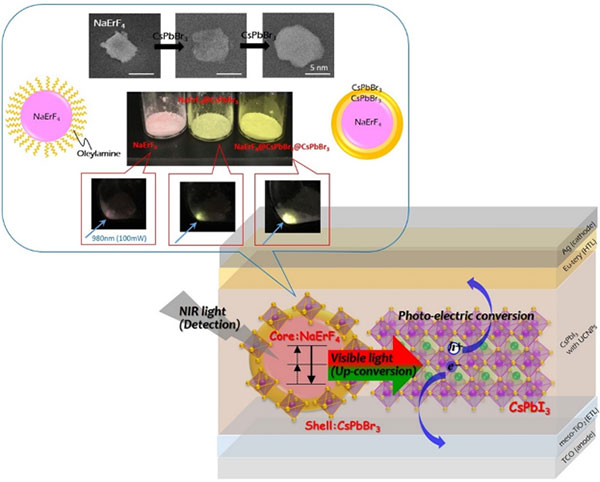Under the JST Strategic Basic Research Program PRESTO, Associate Professor Ayumi Ishii of Teikyo University of Science with her team members has developed a new near-infrared light sensor by using a material that converts weak near-infrared light to visible light.
Near-infrared light is used in a wide range of applications on a daily basis, such as in infrared cameras (night vision cameras), infrared communication (wireless communication), optical fiber communication, remote control, and biometric authentication. The detection of weak light in the near-infrared region and improvement of sensitivity are indispensable for the advancement in optical communication technology, medical diagnosis, environmental monitoring, and other fields. Compound semiconductors (e.g., InGaAs) having an optimal absorption band of 900–1700 nm, are used to detect light in the near-infrared region. However, these systems are expensive because of their complicated manufacturing process that involves the use of rare metals and is limited by noise interference. Moreover, such semiconductors do not exhibit visible light detection accuracy comparable to that achieved using silicon (Si) and other compounds.
The research team has developed core–shell lanthanide based-upconversion(1) nanoparticles that can convert weak near-infrared light to visible light with high efficiency. Furthermore, by developing a near-infrared photodetector (photodiode) that combines these nanoparticles with an inorganic semiconductor material (lead halide perovskite)(2) that responds to visible light, they succeeded in converting the difficult-to-detect weak near-infrared light into electrical signals with an efficiency of 75%. In other words, by using the novel, inexpensive, and simple method of converting near-infrared light—which is considered difficult to detect with high sensitivity—to visible light that can be detected with high precision by using existing technologies and materials, the team has achieved drastic improvement in the efficiency of weak near-infrared light detection.
This achievement promotes the proposal of a new resource- and energy-saving near-infrared light detection method using a nanomaterial that converts low-energy near-infrared light to high-energy visible light. As this technology enables weak light in the near-infrared region, whose detection and utilization are difficult even in sunlight, by converting it to visible light, it can significantly improve the near-infrared light reception sensitivity of optical sensors and the efficiency of sunlight utilization in artificial photosynthesis of solar cells, among others.
This research was conducted in collaboration with Specially Appointed Professor Tsutomu Miyasaka of Toin University of Yokohama. In this research project “Development of organic–inorganic hybrid interfaces for a one-photon sensing device” in the domain of “Fully-controlled photons and their proactive usage for new era creation” under the JST Strategic Basic Research Program PRESTO, the team has aimed at overcoming the limits of sensing functions such as light reception, measurement, and imaging, by realizing ultra-sensitive photodetection that involves the sensing of light at the single-photon level. By adopting a material-chemical approach wherein the organic and inorganic materials are fused at the interface, this research aims to develop multifunctional and highly sensitive photodetectors that can provide information related to various aspects of light (e.g., wavelength and anisotropy (polarization)) to the maximum extent possible at the single-photon level.
*(1) Upconversion
Upconversion is a phenomenon wherein two or more photons are successively absorbed to emit light with a shorter wavelength than the excitation wavelength. Upconversion can be utilized to convert low-energy light such as near-infrared light to high-energy light such as visible light or ultraviolet light. Representative mechanisms include two-photon absorption and triplet–triplet annihilation in organic materials and multi-step excitation of nanoparticles containing rare earth ions; these mechanisms have been extensively researched.
*(2) Lead halide perovskites
Lead halide perovskites are one of the semiconductor materials expected to replace Si as the next-generation solar cell material. Although the material exhibits a high energy conversion efficiency of over 20%, its bandgap can only absorb visible light in a limited range of less than 800 nm. Perovskite films can be easily fabricated by the spin-coating technology, thereby enabling lower cost manufacturing and lower energy consumption than those of inorganic semiconductor materials.
-

Fig.1 Up-converting NIR light detection of lead halide perovskite device A perovskite-based photodetecting device for near-infrared(NIR) light was prepared by using perovskite coated up-conversion nanoparticles(UCNPs) with strong NIR absorption and high UC efficiency. ©JST
Program Information
- JST PRESTO
- Research Area “Fully-controlled photons and their proactive usage for new era creation (FRONTIER)”
- Research Theme “Development of organic-inorganic hybrid interfaces for a one-photon sensing device”
Journal Information
Ayumi Ishii and Tsutomu Miyasaka, “Upconverting Near-infrared Light Detection in Lead Halide Perovskite with Core-shell Lanthanide Nanoparticles”, Advanced Photonics Research, Published online December 9, 2022, doi: 10.1002/adpr.202200222
Contact
-
[About Research]
Ayumi Ishii
Associate Professor, Faculty of Life and Environmental Sciences,
Teikyo University of Science
Tel:+81-554-63-6854
E-mail: ayumi-intu.ac.jp
-
[About Program]
Yuko Shimabayashi
Department of Strategic Basic Research, JST
E-mail: prestojst.go.jp
